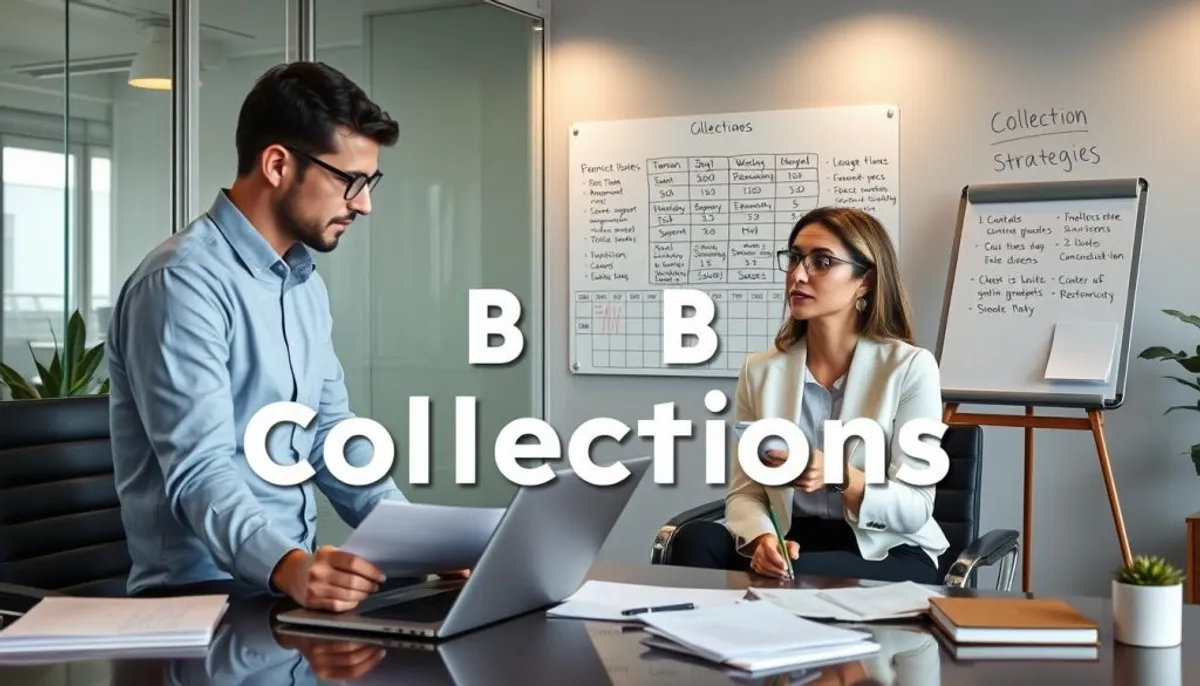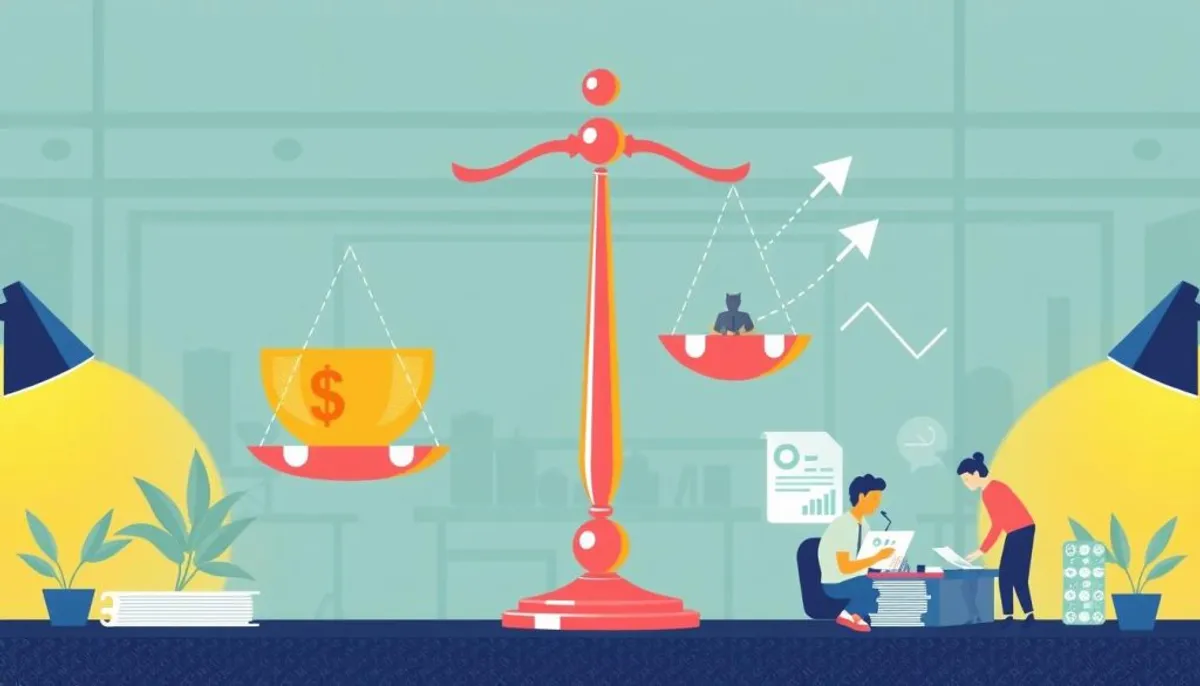
In the realm of business, the management of accounts receivable is paramount. B to b collections are essential for a company’s financial stability. The efficacy of debt recovery services can either bolster or undermine a business’s cash flow. Let’s explore some pivotal strategies for adept accounts receivable management.
Research indicates that businesses engaging collection agencies tend to recover debts more effectively than those attempting solo efforts. BluWave, for example, connects enterprises with seasoned B2B debt collection consultants. These professionals, with their proven track records and transparent pricing, can substantially enhance commercial collection success rates.
Formulating an effective B2B debt collection strategy necessitates a 1-2 week analysis phase, followed by a 3-4 week design period. This meticulous process is critical, given the nature of B2B transactions. These often involve fewer customers but carry higher stakes than B2C dealings. Unpaid B2B invoices can severely disrupt cash flow, underscoring the importance of diligent accounts receivable management.
Key Takeaways
- Hiring professional collection agencies increases debt recovery success
- B2B collections involve higher stakes and more complex relationships
- Developing an effective collection strategy takes 4-6 weeks on average
- Clear communication and proactive monitoring prevent payment delays
- Flexible payment options encourage prompt debt settlement
- Detailed record-keeping is crucial for successful debt recovery
- Technology plays a vital role in streamlining the collection process
Understanding B to B Collections Fundamentals
Business-to-business collections stand out from consumer collections. In the realm of commercial debt collection, grasping these distinctions is vital for achieving success. Let’s dive into the core elements of B2B collections and their significance.
Differences Between B2B and B2C Collections
B2B collections involve intricate relationships and substantial transactions. Unlike B2C, where speed is paramount, B2B emphasizes long-term alliances. B2B entities typically boast higher Customer Lifetime Value, thanks to repeated purchases and larger transaction amounts.
B2B transactions necessitate specialized support teams to navigate their intricacies. This hands-on strategy is critical, given that 94% of B2B buyers consult online reviews, and 72% find negative feedback enlightening for product understanding.
Key Stakeholders in Commercial Collections
In B2B collections, several decision-makers are involved. This contrasts sharply with B2C, where individual consumers make swift decisions. B2B marketers leverage this, with over 60% achieving success through collaborations with microinfluencers to engage with pivotal stakeholders.
The Importance of Business Relationships
Preserving positive relationships is paramount in B2B collections. Unlike B2C, where transactions are typically singular, B2B thrives on continuous partnerships. This underscores the importance of a robust online presence and reputation management in commercial debt collection, as 75% of B2B buyers utilize social media for their purchases.
Common Challenges in Commercial Debt Recovery
B2B debt collection presents unique hurdles for businesses. With approximately 2.6 million small businesses in Texas alone, the scale of potential delinquent account recovery is significant. B2B debts often involve larger sums compared to consumer debts, making effective overdue invoice collections crucial for maintaining cash flow.
Communication barriers pose a major challenge in commercial debt recovery. Businesses may struggle with time zone differences, language issues, and cultural variations in debt payment attitudes. These factors can complicate negotiations and delay resolutions.
Payment disputes and financial difficulties of debtors are common obstacles. Businesses must navigate these sensitively to preserve valuable relationships while pursuing debt recovery. This balancing act is critical, as future business opportunities may depend on how current collection efforts are handled.
| Challenge | Impact | Solution |
|---|---|---|
| Communication Barriers | Delayed resolutions | Multi-channel communication |
| Payment Disputes | Strained relationships | Negotiation and mediation |
| Debtor Financial Issues | Increased risk of non-payment | Flexible payment plans |
| Legal Complexities | Costly and time-consuming | Expert legal counsel |
Businesses often delay hiring collection agencies, reducing recovery chances after 120 days past due. Striking a balance between persistent follow-ups and avoiding overly aggressive tactics is key to successful delinquent account recovery while staying compliant with regulations.
Essential Components of a Strong Credit Policy
A robust credit policy is the cornerstone of effective accounts receivable management. It directs businesses in making prudent financial decisions and managing risk. Let’s dissect the pivotal elements that constitute a strong credit policy.
Credit Limit Assessment Guidelines
Establishing suitable credit limits is vital for preserving healthy cash flow. Credit management teams employ FICO scores, spanning from 300 to 850, to gauge a customer’s creditworthiness. They also scrutinize debt-to-income ratios, with a preference for ratios below 36%.

Payment Terms and Conditions
Transparent payment terms are indispensable for seamless accounts receivable management. These terms delineate payment due dates and any penalties for tardiness. For instance, businesses might extend early payment discounts or necessitate down payments for substantial orders.
Risk Management Strategies
Effective credit policies integrate diverse risk management strategies. These encompass:
- Implementing internal risk rating systems
- Setting limits on customer concentration
- Diversifying across industries
- Regular monitoring of customer financial health
By embracing these strategies, enterprises can curtail potential losses and uphold a healthy accounts receivable portfolio.
| Credit Policy Type | Characteristics | Risk Level |
|---|---|---|
| Loose | Extends credit to below-average profiles | High |
| Moderate | Balances risk and opportunity | Medium |
| Tight | Only grants credit to above-average risks | Low |
Implementing Effective B to B Collections Strategies
Professional debt collectors understand that successful B2B debt collection necessitates a strategic approach. A B2B debt collection agency concentrates on three critical areas: communication, documentation, and timeline management. These elements are fundamental to the success of debt collection efforts.
Communication Best Practices
Clear communication is paramount in B2B collections. Studies indicate that about 70% of businesses experience enhanced payment times when they include detailed payment instructions on invoices. Professional debt collectors stress the significance of proactive communication to avert payment issues.
Documentation Requirements
Proper documentation is essential for successful debt recovery. It encompasses maintaining precise records of invoices, payment agreements, and all communications. A B2B debt collection agency relies on comprehensive documentation to bolster collection efforts and provide evidence if legal action is required.
Timeline Management
Efficient timeline management is crucial for effective collections. Businesses that adopt a systematic approach to following up on overdue payments are more likely to manage nonpaying clients effectively. Professional debt collectors advocate for establishing clear payment deadlines and automating reminders to streamline the collection process.
By concentrating on these strategies, a B2B debt collection agency can substantially enhance collection rates and preserve positive business relationships. Tailoring services to customer needs and offering flexible payment options can also boost collection success.
Automating the Collections Process with ti3
Streamlining unpaid invoice recovery and accounts receivable management is crucial for businesses. The ti3 platform offers a cutting-edge solution to automate and optimize these processes.
Features and Benefits of ti3 Platform
Ti3 is a SaaS platform designed to manage overdue accounts efficiently. It offers automated reminders, issue escalation, and streamlined payment collection. This cost-effective alternative to traditional debt collection agencies helps maintain client relationships while achieving better results.
Setting Up Automated Reminders
Users can easily set up customized reminder sequences with ti3. This feature saves time and ensures consistent follow-ups on unpaid invoices. By automating this process, businesses can reduce the 14 hours spent weekly on administrative tasks related to collecting payments.
Payment Collection Integration
Ti3 integrates various payment methods to facilitate faster collections. This integration is crucial, as businesses are owed an average of $300,000 in late payments. By streamlining the payment process, ti3 helps improve cash flow and reduces the risk of business failure due to unpaid invoices.
- Automated reminders reduce time spent on collection tasks
- Customizable sequences for personalized follow-ups
- Integrated payment options for faster collections
- Comprehensive reporting tools for better insights
By leveraging ti3’s automation capabilities, businesses can significantly improve their accounts receivable management and unpaid invoice recovery processes. This leads to better cash flow, stronger client relationships, and increased overall efficiency.
Dispute Resolution and Prevention Techniques

In the realm of b to b collections, disputes can hinder the recovery of delinquent accounts. Common causes include pricing disagreements, quality issues, and administrative errors. To overcome these hurdles, businesses must employ effective dispute resolution strategies.
Effective communication is paramount. Establish clear expectations regarding payment terms and product quality from the outset. This proactive approach helps avert potential disputes. Should issues arise, address them swiftly. Prompt resolution can prevent minor problems from escalating into significant issues.
Exploring alternative dispute resolution methods can be beneficial. Options like negotiation and mediation are often quicker and less expensive than litigation. These strategies can help resolve conflicts while preserving business relationships.
| Dispute Type | Description | Prevention Strategy |
|---|---|---|
| Pricing | Differences between agreed and charged amounts | Clear pricing documentation |
| Quality | Issues with product or service quality | Detailed quality standards in contracts |
| Administrative | Missing or incorrect billing documents | Streamlined document management |
Automation plays a crucial role in enhancing dispute management. It minimizes errors, saves time, and boosts transparency. An automated system can monitor actions, ensure compliance, and offer insights for future prevention.
The objective of dispute resolution in b to b collections extends beyond mere financial recovery. It aims to find mutually beneficial solutions and maintain crucial business relationships.
Legal Considerations in Commercial Collections
In the realm of business-to-business collections, legal intricacies are paramount. Grasping these complexities is essential for businesses aiming to efficiently manage commercial debt collection.
Compliance Requirements
Business-to-business collections are exempt from the Fair Debt Collection Practices Act (FDCPA) regulations. Yet, adherence to other legal frameworks is imperative. These mandates differ by state and industry. Familiarity with the specific laws governing your business is crucial to sidestep legal entanglements.
Documentation Standards
In the context of commercial debt collection, meticulous record-keeping is indispensable. This encompasses contracts, invoices, and communication logs. The precision and organization of these documents can significantly influence outcomes should legal proceedings become necessary.
Enforcement Options
Businesses confronting unpaid debts have several avenues to pursue:
- Send demand letters
- Make direct contact attempts
- Hire specialized B2B collection agencies
- Take legal action as a last resort
Each strategy carries its own legal connotations. It is prudent to meticulously evaluate these implications before selecting a course of action.
| Enforcement Option | Legal Implications | Typical Timeline |
|---|---|---|
| Demand Letters | Low legal risk | 30-60 days |
| Direct Contact | Moderate legal risk | 60-90 days |
| Collection Agency | Moderate to high legal risk | 90-180 days |
| Legal Action | High legal risk | 180+ days |
By comprehending these legal nuances, businesses can enhance their commercial debt collection strategies while adhering to legal standards.
Measuring Collection Performance and KPIs
Effective accounts receivable management and debt recovery services hinge on tracking key performance indicators (KPIs). These metrics offer insights into the efficiency of collection processes. By monitoring them, businesses can refine their strategies and bolster their financial health.
Key Metrics to Track
Several essential KPIs provide insights into collection efficiency:
- Days Sales Outstanding (DSO): Measures average time to collect payments
- Collection Effectiveness Index (CEI): Evaluates ability to retrieve receivables
- Right Party Contacts (RPC) Rate: Assesses efficiency in locating debtors
- Promise to Pay (PTP) Rate: Indicates success of collection calls
- Profit per Account (PPA): Shows average profit from each collection account
Performance Analysis Tools
Businesses can leverage various tools to analyze collection performance:
- Aging reports: Track overdue accounts by time periods
- Collection dashboards: Visualize key metrics and trends
- AR turnover ratio: Measure efficiency in collecting from customers
- Expected cash collections: Project future cash inflows
Improvement Strategies
To enhance collection performance, consider these strategies:
- Regularly review and adjust credit policies
- Offer multiple payment options on invoices
- Implement automated reminders for overdue payments
- Establish a methodical collections process
- Monitor revenue leakage and average days delinquent
By focusing on these KPIs and implementing effective strategies, businesses can streamline their debt recovery services. This improvement will enhance overall financial performance.
| KPI | Description | Importance |
|---|---|---|
| Days Sales Outstanding (DSO) | Average time to collect payments | Indicates collection efficiency |
| Collection Effectiveness Index (CEI) | Ability to retrieve receivables | Measures overall collection performance |
| Right Party Contacts (RPC) Rate | Efficiency in locating debtors | Improves contact success rates |
| Promise to Pay (PTP) Rate | Success of collection calls | Indicates likelihood of payment |
| Profit per Account (PPA) | Average profit from each collection account | Assesses financial impact of collections |
Conclusion
Mastering b to b collections is essential for maintaining a healthy cash flow and fostering robust business relationships. Implementing effective business debt recovery tips can significantly enhance a company’s financial health. The path from initial invoicing to successful payment collection necessitates a strategic approach and the appropriate tools.
Small Claims Court and mediation serve as cost-effective avenues for resolving disputes in B2B transactions. For more intricate cases, arbitration offers binding decisions. Debt collection agencies bring expertise in negotiating payment plans, crucial for recovering unpaid debts. The dunning process, beginning with polite reminders and potentially escalating to legal action, is a pivotal aspect of b to b collections.
Automation tools, such as ti3, can streamline the collections process, boosting efficiency and consistency. Yet, human intuition remains indispensable in handling late payments on an individual basis. By integrating automated processes with personalized approaches, businesses can refine their b to b collections strategies. This ensures timely payments while preserving positive client relationships.
RelatedRelated articles



